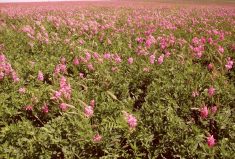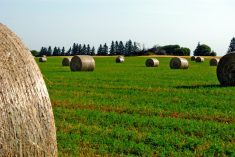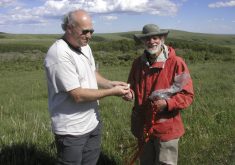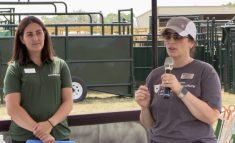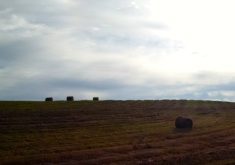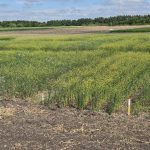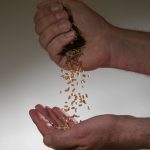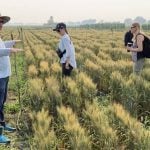While rain has generally improved conditions in Western Canada, a hay shortage looms in many regions.
On Monday morning, the federal government released its initial list of regions eligible for livestock tax deferrals.
The tax deferral allows livestock producers in designated areas to defer some of their 2019 sales to 2020, in order to restock their herds. The idea is that the cost of replacing those animals in 2020 will offset the deferred income, reducing the tax burden of the original sale. Eligible regions face a forage shortfall of 50 per cent or more, due to excess or lack of moisture.
Read Also

Why post-drought pasture management matters for beef farmers
Pasture management is always important, but it is especially important following a drought. During these challenging periods, pastures may suffer…
This year, regions in B.C., Alberta, Manitoba, Saskatchewan and Quebec were sufficiently dry to trigger the tax deferral.
Alberta
In the south, more rain along the foothills means the hay is far superior to that in the eastern part of the region. Tame pasture is currently rated at 25 per cent poor, 34 per cent fair, 37 per cent good and four per cent excellent. First cut dryland hay is 66 per cent complete with estimated yields of one ton per acre and quality rated as 60 per cent good and excellent. Irrigated hay is 85 per cent complete with estimates of 2.1 ton per acre yields and 78 per cent rated as good or excellent. The wetter areas to the west are waiting on drier conditions to proceed with haying operations.
Rain in central Alberta has stalled haying. First cut dryland hay is 13 per cent complete with estimated yields of 1.3 ton per acre and quality rated as 27 per cent good. Irrigated hay is two per cent complete with estimates of 2.2 ton per acre yields and 80 per cent rated as good.
Northeastern Alberta’s tame pastures rate as three per cent poor, 13 per cent fair, 77 per cent good and seven per cent excellent. The first cut of hay is three per cent complete, with estimated yields of 1.1 ton per acre and quality rated as 77 per cent good and excellent. Rain has stalled haying operations.
Rain is holding up haying in the northwest as well. Tame pasture rates five per cent fair, 85 per cent good and 10 per cent excellent. Six per cent of the first cut is complete, with estimated yields of 1.5 ton per acre and quality rated as 64 per cent good and excellent.
In the Peace, tame pasture rates as eight per cent poor, 43 per cent fair, 41 per cent good and eight per cent excellent. First cut dryland hay is 18 per cent complete with estimated yields of 1.5 ton per acre. Hay quality rates as 78 per cent good and excellent.
Saskatchewan
Saskatchewan producers now have 13 per cent of the hay crop cut and eight per cent baled, the latest crop report notes.
Provincially, hay quality rates as three per cent excellent, 42 per cent good, 42 per cent fair and 13 per cent poor. Hay yields are below average. Many areas also saw severe weather, including hail and strong winds.
In the southeast, 12 per cent of the hay crop is cut and eight per cent baled or silaged. Hay quality is rated as 48 per cent good, 38 per cent fair and 14 per cent poor. Producers report that hay yields are below average and that they will need to find alternative feed sources. Pastures have improved, but may have a reduced carrying capacity into the summer and fall.
Haying continues in the southwest. Livestock producers now have 14 per cent of the hay crop cut and 10 per cent baled or silaged. Hay quality is rated as 12 per cent excellent, 47 per cent good, 35 per cent fair and six per cent poor. Hay yields are below average and some producers will have to source feed for their livestock. Pastures have improved — some significantly — but generally will have a reduced livestock carrying capacity.
Ten per cent of the hay crop has been cut in east-central Sask., and six per cent baled or silaged. Hay quality is rated as five per cent excellent, 26 per cent good, 37 per cent fair and 32 per cent poor. Hay crops will have a significantly reduced yield and pastures, while improved, may have a reduced carrying capacity into the summer months.
In west-central Sask, 20 per cent of the hay crop is cut and nine per cent baled or silaged. Hay quality is rated as 41 per cent good, 41 per cent fair and 18 per cent poor. Although hay crops and pastures have improved, yields are significantly lower than average and producers will need to find alternative feed sources. Pasture conditions have improved from the moisture, but they will have a reduced livestock carrying capacity.
Haying is well underway in the northeast, with 25 per cent of the crop cut and 10 per cent baled or silaged. Hay quality is rated as 39 per cent good and 61 per cent fair. Many producers have indicated that there will be below-average hay yields. Pasture conditions have improved with a limited carrying capacity.
Manitoba
Most areas received a good amount of rain recently, the latest Manitoba crop report notes. But hay yields are below normal across the province, with the Interlake seeing the most severe shortages.
In the southwest, haying is underway. Rains since mid-June have helped pastures and hay production. Still, hay yields are below average. Rain improved dugout levels, but they’re not yet fully recharged. The far southwest corner of Manitoba and south of Riding Mountain National Park are still drier than the rest of the region. Some producers have begun hauling water and some native hay will not be worth cutting. Most annual crops seeded for greenfeed and silage are doing well.
Haying is underway in the northwest. Grass hay yields are 30 to 50 per cent of normal. Newer stands with more alfalfa are yielding 50 to 60 per cent of normal. Spotty rain showers are welcome since primarily hot and dry conditions are dampening growth in both annual crops and in perennial forage fields. Pastures grazed early in the spring are starting to regrow with the limited additional moisture. Pastures and wild hay are very poor north of Dauphin and in the Rorketon, Alonsa, Crane River and Ethelbert areas. There is minimal regrowth on earlier grazed pastures in these areas. Grasshoppers are also a major concern.
The first cut is underway in central Manitoba, with yields looking to be 25 per cent to 50 per cent of normal. Second cut is more promising in areas that saw significant rain, but fields are browning elsewhere. Pasture growth and hay yields are best in the south-central part of the region and yields are better than expected. But pasture regrowth is minimal or non-existent in drier areas. Straw will be needed for roughage. Culling has begun and will increase if conditions remain dry. Livestock water supplies are getting low, affecting water quality.
In eastern Manitoba, hay field condition rates as 20 per cent good, 40 per cent fair, 20 per cent poor and 20 per cent very poor. Pastures rate as 10 per cent good, 50 per cent fair, 20 per cent poor and 20 per cent very poor. Most first cut yields look to be 50 per cent to 60 per cent of normal. Livestock are being rotated through pastures as rains have helped improve growth. Half of first cut hay is still standing, and 10 per cent is cut and 40 per cent baled or silaged. Quality was rated as good. Alfalfa hay yield was one tonne per acre on average. Average grass/alfalfa hay yield was 0.75 tonne per acre.
Rain has greened up some pasture in the Interlake, but growth has stalled in the driest areas. First cut hay yields are extremely variable, depending on moisture, but reports estimate 30 to 60 per cent of average production. Second cut will be limited, if any. Some producers will limit cutting to improve winter survival of these stressed acres. Close to 50 per cent of native hay acres will not be cut due to poor stands. Pastures are rated as fair (30 per cent), poor (20 per cent) to very poor (50 per cent). Hay fields rated as fair (30 per cent), poor (20 per cent) to very poor (40 per cent). Topsoil moisture for hay and pasture is rated as 70 per cent short and 30 per cent very short. Producers in the north Interlake are hauling water to pasture and concern is growing about water supply. Overall, livestock water supply is rated as 70 per cent adequate.
Note: There is no recent field crop report for Ontario available at this time.
Do you have a current photo illustrating the pasture or feed situation in your area that you’d like to share? Send it to [email protected] (subject line: Feed Watch) or tweet it to @LtoG. Be sure to share your name, location and some information about the situation in your region.




